Discover the majestic Jain temples of Karnataka, where fine artistry meets profound devotion in a celebration of faith and heritage. Mahavir Jayanti in April, marks the birth of the 24th and revered Tirthankara, Lord Mahavir.
Karnataka, in South India, has a deep history of Jainism, a religion supported by many important ancient kingdoms like the Rastrakuta Dynasty, Western Ganga, Kadamba, Chalukya dynasties, and the Hoysala Empire. Hence, the state has many Jain sites, including temples, big statues of Gommata, and pillars.
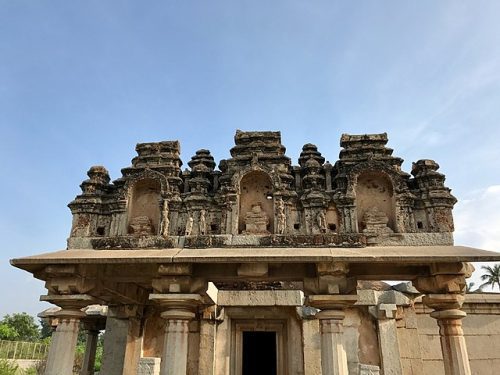
Karnataka is widely known as a Jain pilgrimage site. While the big festival Mahamastabhisheka at Shravanabelagola attracts crowds from across India, the Jain temples in places like Moodabidri or the north part of the state are architectural gems worth visiting. During Mahamastabhisheka, the Gomateshwara statue is bathed in milk, sandalwood paste, turmeric, and more, in a grand event held every 12 years. Just like it’s known for its natural diversity, Karnataka is also celebrated for its rich mix of culture and religion.
The exploration of Jain temples of Karnataka reveals not just architectural marvels but also a profound narrative of spirituality, history, and cultural integration. These temples serve as custodians of an ancient religion that preaches non-violence, austerity, and the well-being of all living beings, standing as serene testaments to Jainism’s enduring legacy in the region.
Through the intricate designs, meticulous carvings, and sacred spaces of these edifices, one can glimpse the profound reverence for life that characterizes Jain philosophy, making them more than mere structures of worship; they are embodiments of an ethos.
Karnataka, with its rich tapestry of history, has been a pivotal ground for Jainism, hosting an array of temples that narrate stories of faith, resilience, and architectural ingenuity. From the majestic statue of Gommateshwara in Shravanabelagola to the intricately carved temples of Moodbidri and the ancient edifices in Halebidu, each site offers a unique insight into the spiritual and artistic accomplishments of Jain communities.
These temples, through their architectural diversity, highlight the adaptability and openness of Jainism to regional influences while retaining the core tenets of its doctrine.
The architectural features of these temples, characterized by detailed imagery, elaborate motifs, and symmetrical patterns, not only showcase the artistic excellence of the past but also serve as a medium of spiritual teaching. The depiction of Tirthankaras, celestial beings, and scenes from Jain mythology on temple walls educate devotees and visitors alike about the religion’s rich lore and ethical foundations. Furthermore, the placement of temples in serene and picturesque settings enhances the spiritual experience, inviting introspection and peace.
The significance of Jain temples in Karnataka extends beyond their religious and architectural dimensions; they are vital components of the state’s cultural heritage. These temples have been centers of learning, social gatherings, and cultural activities, fostering a sense of community and continuity among followers.
The preservation and study of these historical sites offer invaluable insights into ancient Indian society, its values, and its cosmological views, contributing to our understanding of human civilization’s diverse expressions.
In contemporary times, Jain monuments in Karnataka continue to fascinate scholars, pilgrims, and tourists from around the world. Their timeless appeal lies not just in their aesthetic grandeur but in their ability to convey a message of harmony, discipline, and respect for life.
As we move forward in an era marked by rapid changes and challenges, these temples remind us of the importance of sustaining our cultural heritage and the values they represent. They stand as beacons of peace and spiritual solace, inviting individuals from all walks of life to pause, reflect, and find solace in the tranquillity they offer.
Explore these great Jain Temples of Karnataka
Sri Manjunatha Temple Dharmasthala
Located in the lush Western Ghats, Dharmasthala is a famous pilgrimage spot by the Netravati River in the Belthangady area of Dakshin Kannada district. It stands out as a unique mix of different beliefs and is probably the most popular religious site in Karnataka. Dharmasthala shines as a symbol of unity across communities, religions, and cultures. The main temple, dedicated to Lord Shiva, is run by a Jain family known as the Heggades and surprisingly, has Vaishnavaite priests.
A giant 39-foot statue of Lord Bahubali, reflecting Jain traditions, is located near the temple. Here, both the Jain Tirthankara and Lord Shiva are honoured at the same sacred place. Giving to those in need is part of Dharmasthala’s ethos, offering free meals to visitors of any background. The annual festival, Laksha Deepotsava, lights up the place with one lakh lamps and includes talks on literature and religion.
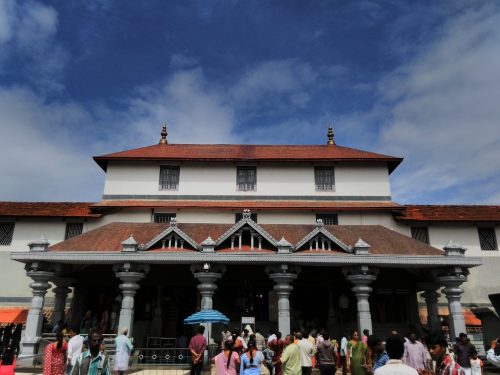
The story of Dharmasthala Temple began around 800 years ago with a divine message to the local leader, Birmanna Pergade, inspiring him to devote his home to righteousness or Dharma. The Pergade family moved out and turned their original house into a place of worship. Following further divine guidance, four deities were enshrined and professional priests were brought in. At the priests’ advice, a Shiva Linga from Kadri near Mangaluru was installed, leading to the creation of the Manjunathaswamy Temple.
Shravanabelagola, located roughly 150 km northwest of Bangalore, Karnataka’s capital, has been a key site for Jain culture, including its art, architecture, and religion, for over 2000 years. It became famous when Bhagawan Bhadrabahu, a leading Jain teacher, and his followers came here from Ujjain, Madhya Pradesh, around two thousand years ago. This place also became the retirement spot for the famous emperor Chandragupta Maurya, who, influenced by Bhadrabahu, gave up his throne to his son and settled here.
Shravanabelgola
This town is a significant Jain pilgrimage spot in South Karnataka. It’s known for the impressive 18-meter-tall statue of Lord Gometeshwara, which is one of the tallest monolithic statues in the world. This statue, built in 981 AD by the warrior Chamundaraya from the Ganga dynasty, is made from a single piece of granite and stands atop Vindhyagiri Hill, visible from as far as 30 km away. To get a closer look, visitors need to climb nearly 700 steps carved directly into the rock.
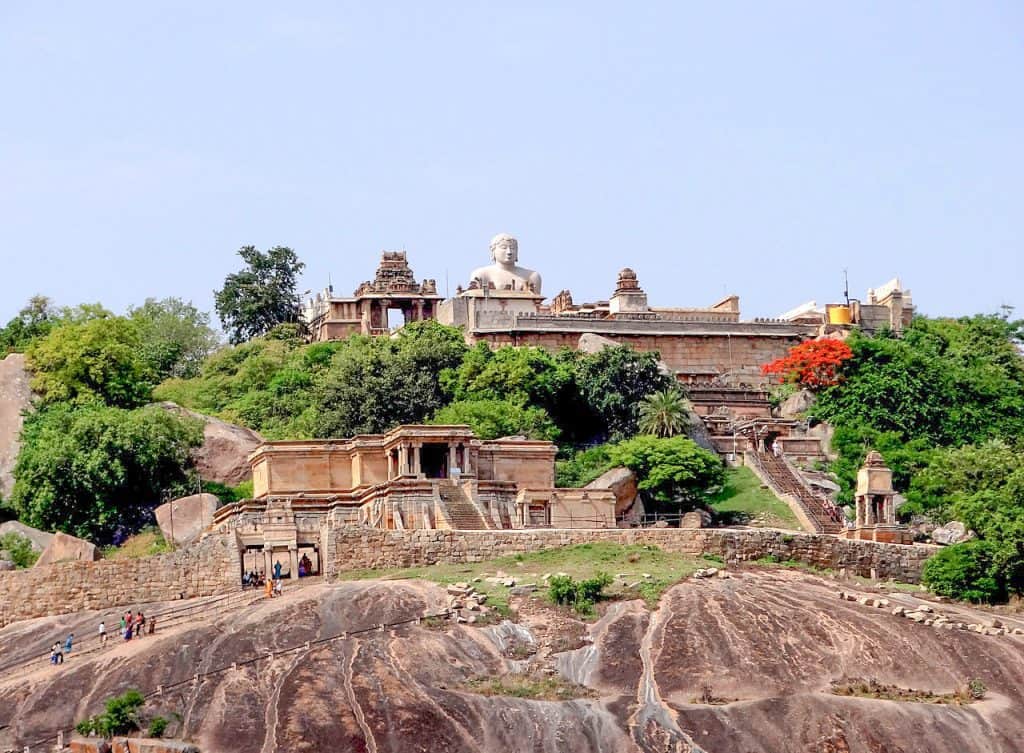
The statue is not just huge but also beautifully detailed, embodying the concept of immense strength without aggression. Surrounding this statue, there are representations of all Jain Tirthankaras, adding to the spiritual ambience. The sight of this giant, peaceful figure of Lord Gomateshwara is bound to leave anyone in wonder.
Kundadri Jain Temple
Kundadri Jain Temple Located on the Theerthahalli-Agumbe road, about 12km from Theerthahalli, Kundadri Hill is a gigantic monolithic rock formation. Surrounded by dense evergreen forests, it is a lovely place for trekking. A rough, stone-paved path leads to a Jain temple, Parshwanath Chaityalaya, a stone structure, perched atop the hill. Camping in the open at Kundadri Hills is an exhilarating experience as from the hilltop you can see the twists and turns of the Thirthahalli-Agumbe road.
The name Kundadri is believed to be derived from the name of Acharya Kundakunda, a popular 4th-century Jain Monk, who is said to have taken shelter in these hills. On top of Kundadri, a 17th-century Jain temple dedicated to the 23rd Tirthankara of Jains, Parshwanatha invites Jain devotees from different parts of the country. The small temple, along with two small ponds form the only building on top of Kundadri hills.
A visit to Kundadri can be clubbed with nearby attractions such as Agumbe (16 km), Sringeri (30 km from Kundadri) and Kuppalli (31 km from Kundadri). Kundadri is 16 km from Agumbe, 90 km from Shivamogga and 350 km from Bengaluru. Public transportation is available till Thirthahalli or Agumbe. Private vehicles or taxis are required to cover the last 15 km to reach the top of Kundadri hills. Roads are steep and not recommended for inexperienced drivers.
Navagraha Jain Temple
The Navagraha Jain Temple, also known as Navagraha Teertha, is located in Varur near Hubli, Karnataka, and is a significant pilgrimage destination for Jains across India. This temple is home to a remarkable 61-foot-tall monolithic statue of Shri 1008 Bhagavan Parshvanatha, making it the tallest statue of Parshvanatha in the country.

Alongside it, there are smaller representations of the eight other Jain Tirthankaras, each associated with one of the nine planets, suggesting a unique celestial connection. The entire structure, including the statue and its 48-foot pedestal, reaches a total height of 109 feet.
Initiated in January 2005, the creation of Navagraha Teertha was overseen by Sri Gunadhar Nandi Maharaj and received support from Sri Dharmasena Bhattaraka Swamiji, with the monolithic statues completed within a year. This site is particularly noted for its spiritual significance in addressing the astrological impacts of the nine planets through the veneration of the nine Tirthankaras.
The grand statue of Lord Parshwanth is not only striking in its beauty but also surpasses the size of the Gomateshwara or Lord Bahubali statue in Shravanabelagola. Visible from up to 4 km away along the national highway, the statues of Navagraha Teertha present a majestic sight to those passing by the Tapovan flyover exit near Varur.
Chaturmukha Basadi
This unique Jain temple, tucked away in a quiet coconut grove, offers a tranquil retreat from city life. What makes this temple special is that visitors can enter its main sanctuary from all four directions, earning it the name ‘chaturmukha,’ which means ‘four faces.’ In South India, Jain places of worship are referred to as ‘Basadi.’ During your visit, you can explore other Jain temples in the area like Kere Basadi, Padmavati Basadi, and the Gommateshwara statue in Karkala.
The Chaturmukha Basadi, a famous Jain temple from the 16th century, is located in Karkala, a town and the administrative centre of the Udupi district along the coastal part of Karnataka. This temple stands on a raised area surrounded by coconut trees and rice fields. ‘Chaturmukha’ means ‘four faces,’ reflecting the temple’s design with four open sides and doorways leading to the central sanctum. These entrances are adorned with carvings of various Jain Tirthankaras and Hindu deities.
With 108 granite pillars, Chaturmukha Basadi is a sight to behold. The Gomateshwara Statue, another notable landmark, is just 1.4 km away. Another temple worth visiting is in Varanga, 27 km from Karkala, situated in the middle of a picturesque pond.
Karkala is 361 km from Bengaluru and 51 km from Mangaluru, with the latter being the nearest airport and railway station. The town is accessible by bus from Udupi and Mangaluru. The temple itself is only 1.3 km from the centre of Karkala, easy to reach by walking or by taking an auto.
Gomatagiri
Gomatagiri, located in the Bettadoor area of Mysuru district, is renowned for its smaller version of the Gomateshwara (Bahubali) statue. This 20-foot tall monolithic statue stands on Gomatagiri hill, about 164 feet above the ground, and is approximately 700 years old, marking it as a significant Jain worship site in the region.
Each year, the statue is honoured with a special ‘Abhisheka’ ceremony, where sacred items are poured over it. This grand event, known as Maha Masthakabhisheka, typically occurs in September and offers a spectacular view of the surroundings, including parts of Mysuru city and the KRS Dam in the distance.
Crafted from a single granite stone during the Vijayanagara period, the statue echoes the style of the larger Gomateshwara statue in Shravanabelagola, albeit it is smaller in size (6 meters compared to 17 meters). Nearby attractions include the KRS Dam (20 km away), Balamuri Falls (18 km away), and Arabithittu Wildlife Sanctuary (15 km away), making Gomatagiri a worthy visit alongside these sites.
Gomatagiri is 153 km from Bengaluru and just 22 km from Mysuru. The nearest airport is in Mysuru, 32 km away, with the city’s railway station serving as the closest train link. From Mysuru, visitors can easily reach Gomatagiri by taxi.
Cave Temple
The Badami cave temples are situated in the Badami town, nestled in the north-central region of Karnataka, India. These temples lie approximately 88 miles east of Belgavi and 87 miles northwest of Hampi, with the Malaprabha River located just 3 miles away. The temples are also conveniently placed near other historical sites, being 14 miles from the UNESCO World Heritage site Pattadakal and 22 miles from Aihole, which is home to over a hundred ancient and medieval Hindu, Jain, and Buddhist monuments.
Badami, once the capital of the Chalukya dynasty, is renowned for its mix of structural and rock-cut temples dating back to the 6th and 7th centuries. The city’s foundation was established by Pulakeshi I between 535 and 566 AD, and further enhanced by his son, Kirtivarman I, who added temples and other structures to beautify the city.
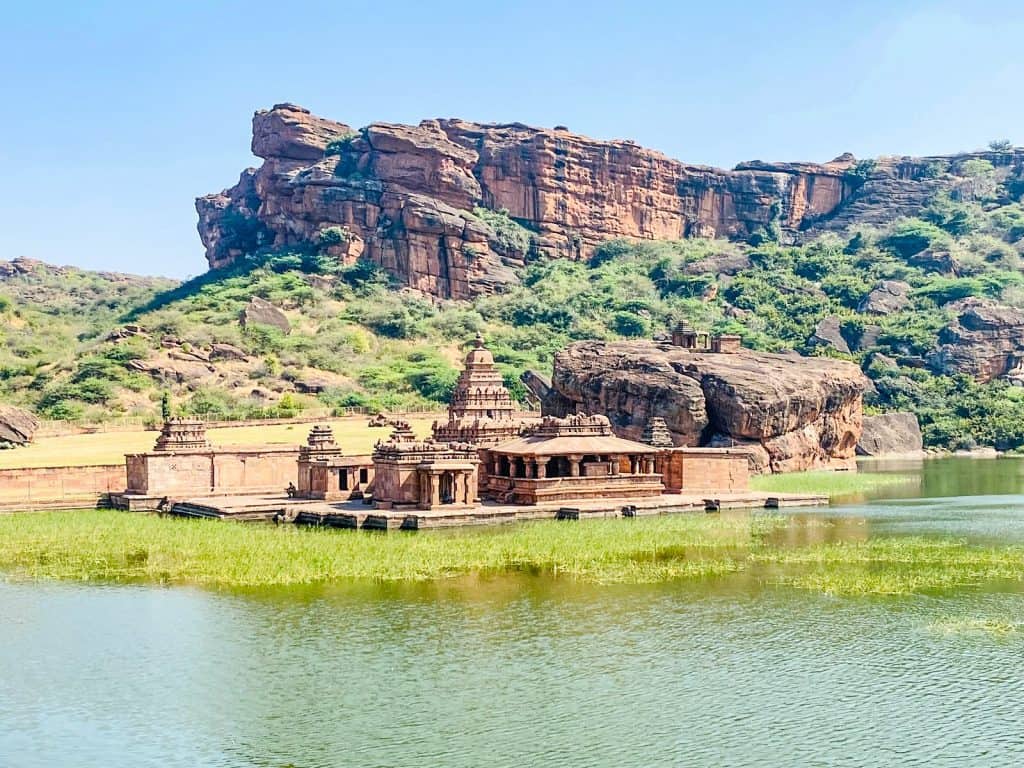
Mangalesha, Kirtivarman I’s brother, between 598 and 610 AD, finished building the cave temples and dedicated them along with a village during the Vishnu image installation ceremony. Pulakeshi II, who reigned from 610 to 642 AD, was the most illustrious ruler of the dynasty, notable for defeating the Pallava King Mahendra Verman I. However, the Pallavas later seized and demolished Badami to retaliate for their loss. Over the centuries, Badami changed hands among various rulers, including the Vijayanagar Kings, the Adil Shahis, the Savanur Nawabs, the Marathas, Hyder Ali, and eventually the British, who incorporated it into the Bombay Presidency.
Thousand Pillars Temple
Dakshina Kannada boasts yet another architectural gem, a temple dedicated to the Jain Tirthankara, Chandraprabhu, who is the eighth Tirthankara in Jainism. The temple’s pillars are a sight to behold, adorned with intricate carvings that narrate stories and symbols from Jainism. This makes the temple not only a spiritual centre but also an educational one, highlighting its historical importance. It stands as a monument to the brilliant minds of 15th-century engineers and sculptors. The temple area, often referred to as the ‘Jain Kashi’ of India, is home to numerous Jain temples, enriching its cultural and religious tapestry.
Another historic treasure in South India is the Thousand Pillar Temple, a UNESCO World Heritage Site. This temple showcases the zenith of the Kakatiya dynasty’s architectural prowess with its 1,000 closely arranged pillars that create the illusion of a wall. Constructed over 72 years, it is a masterpiece dedicated to Lord Shiva, Lord Surya, and Lord Vishnu, embodying the essence of Kakatiya art and architecture.
Its star-shaped structure encompasses three main shrines, or Trikutalayam, each adorned with numerous sculptures depicting ancient epic tales. The entrance to Lord Shiva’s shrine is marked by an imposing statue of Nandi, carved from black basalt rock, greeting visitors. Built in 1163 AD under the reign of Kakatiya king Rudra Dev, the temple is a testament to the artistic and spiritual legacy of its era.
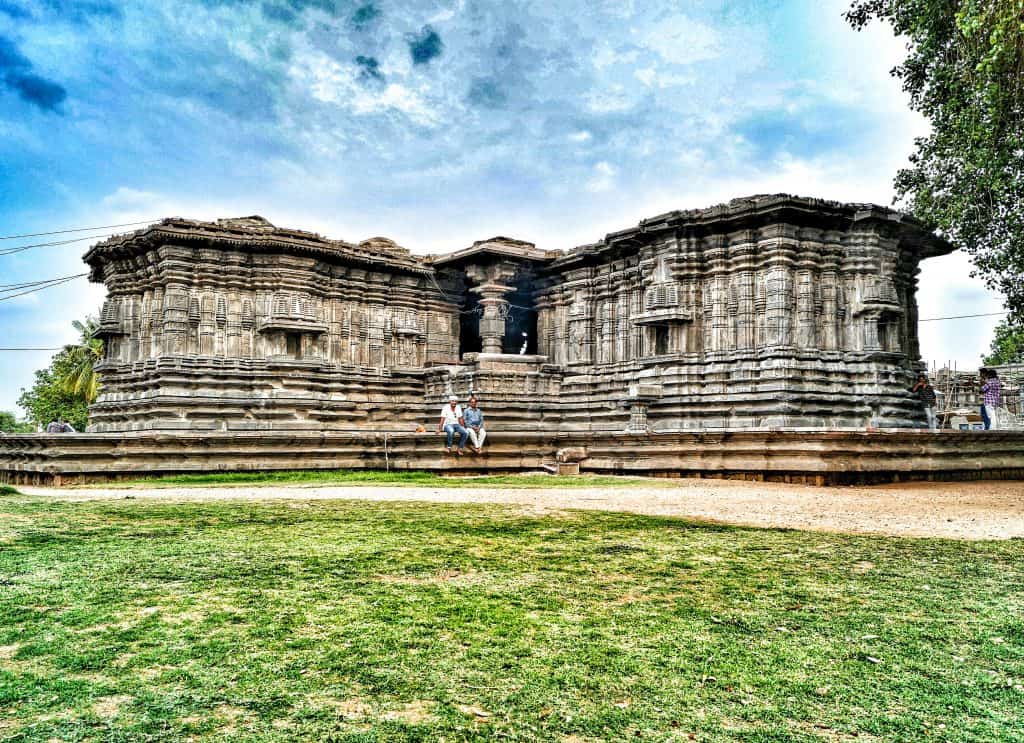
These sites not only embody the spiritual heritage and architectural ingenuity of ancient dynasties but also offer a unique glimpse into the soul of Jainism that has thrived in this region for centuries.
Each temple, with its distinctive features—from the grandeur of Mahamastabhisheka at Shravanabelagola to the intricate designs of the Thousand Pillars Temple—invites devotees and art lovers alike to explore the serene beauty and complex philosophy of Jainism.
The Jain temples of Karnataka are not merely architectural wonders but are profound symbols of a philosophy that espouses compassion, non-violence, and reverence for life.
As custodians of this ancient heritage, these temples invite us to explore the depths of human spirituality and wisdom. They challenge us to embrace tolerance, seek knowledge, and live in harmony with all beings. In the grand tapestry of Karnataka’s cultural and religious landscape, Jain temples occupy a place of distinction, offering lessons that resonate with timeless relevance.
As we continue to explore and preserve these sacred sites, we ensure that the light of Jainism’s profound teachings continues to illuminate the path of humanity towards a more compassionate and understanding world.
Karnataka’s Jain temples, often overshadowed by its natural and cultural landmarks, deserve recognition as pillars of the spiritual and historical landscape of India, beckoning travellers from around the world to witness their timeless majesty.
Read more: Latest



